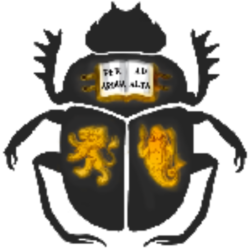In the past Bes has been variously described as ‘monkey’ (Hart 1986: 59), ‘dwarf’ (Altenmüller 1973: 721), ‘Nubian’ (Graves 2011), ‘deformed’ (Zivie-Coche 2011: 7), ‘lionlike’ (Malaise 2000: 180) amongst others, it certainly is not that any of these descriptions are wrong – instead, the confusion over Bes’ imagery arises due to the huge variety of iconographic changes in his appearance over the two millennia that he was worshipped in ancient Egypt. To exemplify the visual development of Bes, this exhibition has chosen to utilise two collections of Egyptian antiquities; the Eton College William Joseph Myers Collection and the Birmingham Museum and Art Gallery collection. While the number of visual traits discussed throughout this exhibit is in no way exhaustive, the aim is to exemplify some features common to depictions of Bes within a chronological typology for the use of undergraduate students and fellow researchers. Each characteristic will be displayed visually using objects taken from both collections and presented in this virtual exhibition through the use of photography and photogrammetry. Those objects with accompanying photogrammetric 3D models (available in pdf format) will be listed with a hyperlink, please right-click and download these documents to view and interact with the objects.
By clicking through the following pages outlining the chronological changes of Bes’ iconography we are able to investigate the elements that may have influenced these developments.
Click the links below to explore…
A. Bes: Development of a Deity
B. ‘Bes’: The Origins
C. Anthropomorphism: From Lion to Man
D. Apotropaic Gestures
E. A Period of Syncretism
F. The Adoption of ‘Bes’ into the Classical World
G. Unanswered questions
Further Reading
Complete Exhibition Catalogue (pdf file)
Exhibition Poster (pdf file)

About the exhibitors
 Carl Graves is a third year PhD candidate of Egyptology at the University of Birmingham and is also the Postgraduate Curator of the Eton College Myers Collection of Egyptian Antiquities currently on loan there. He has also volunteered at Birmingham Museum and Art Gallery since 2008. (cxg653@bham.ac.uk)
Carl Graves is a third year PhD candidate of Egyptology at the University of Birmingham and is also the Postgraduate Curator of the Eton College Myers Collection of Egyptian Antiquities currently on loan there. He has also volunteered at Birmingham Museum and Art Gallery since 2008. (cxg653@bham.ac.uk)
.
 Sarah Chapman is a second year PhD candidate of Egyptology at the University of Birmingham. She specializes in digital imaging and technology in archaeology. She is currently working as the digital imaging specialist for the University of Hawaii excavations at Tell Timai in the Egyptian Delta. She will shortly be creating a virtual exhibition focusing on digital imaging methods for archaeology. (slc252@bham.ac.uk)
Sarah Chapman is a second year PhD candidate of Egyptology at the University of Birmingham. She specializes in digital imaging and technology in archaeology. She is currently working as the digital imaging specialist for the University of Hawaii excavations at Tell Timai in the Egyptian Delta. She will shortly be creating a virtual exhibition focusing on digital imaging methods for archaeology. (slc252@bham.ac.uk)
.
Photography
All images within the exhibition are under the copyright of Sarah Chapman, including two-dimensional images and three-dimensional models, please contact her for any image enquiries slc252@bham.ac.uk.
Acknowledgements
The exhibitors would especially like to thank Mr Adam Jaffer, the Curator of World Cultures at Birmingham Museum and Art Gallery, for his support and assistance in locating the objects for discussion and permitting us to create this display. Gratitude also goes to Eton College for allowing students of the University of Birmingham the opportunity to work with the Myers Collection and in this we would also like to thank Dr Martin Bommas for giving us permission to use these objects to create this unique virtual exhibition and his suggestions in the writing of the text. Finally we would like to thank Birmingham Egyptology for editing the work and giving us the perfect stage to present our work and hope that in the future further projects like this one can be added to the platform.
